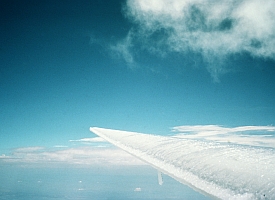Researchers at the National Center for Atmospheric Research (NCAR) in Boulder, Colorado has developed a computer-generated forecast that provides pilots with information on the chance of encountering dangerous in-flight icing conditions. The Federal Aviation Administration provided funding for the project.
Each year in the United States, 20-40 aircraft accidents are linked to in-flight icing encounters, according to NCAR. Icing conditions, created by water droplets from clouds that freeze on the surface of an aircraft. Hazardous icing conditions cost the U.S. aviation industry an estimated $20 million annually in injuries, aircraft damage, and fuel.
The Forecast Icing Product with Severity (FIP-Severity) provides 12-hour icing forecasts that are updated hourly for pilots, air traffic controllers, and others who plan their flight paths over the continental United States.
Marcia Politovich, who leads in-flight icing research at NCAR, says the system will most benefit commuter planes and small aircraft, which are more vulnerable to icing hazards. Smaller aircraft generally cruise at lower, ice-prone altitudes, below 24,000 feet. They also may lack mechanisms common on larger jets that prevent ice buildup, such as heated wing edges.
FIP-Severity calculates the probability of icing based on an analysis of temperature and humidity data associated with clouds, which are the source of in-flight icing. The algorithm gathers real-time information from satellites, radars, weather models, surface stations, and pilot reports, and determines the probability of encountering icing, its expected severity, and the likelihood of large droplet icing conditions.
The new system updates two of NCAR’s system dealing with aircraft icing. Its original Forecast Icing Product estimates the potential for icing, rather than calculating probabilities as does the new system. Another NCAR system, the Current Icing Product depicts severity and probability of an encounter with icing, but only for current conditions, rather than giving forecasts.
* * *


 RSS - Posts
RSS - Posts
You must be logged in to post a comment.